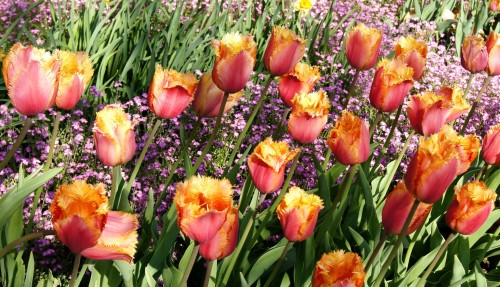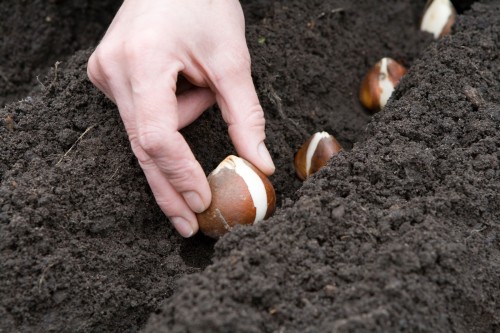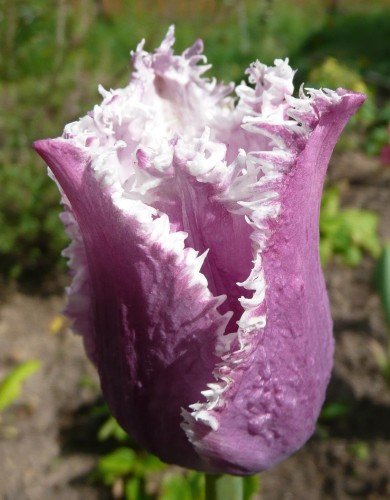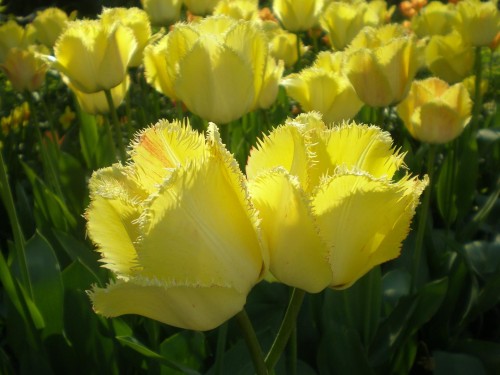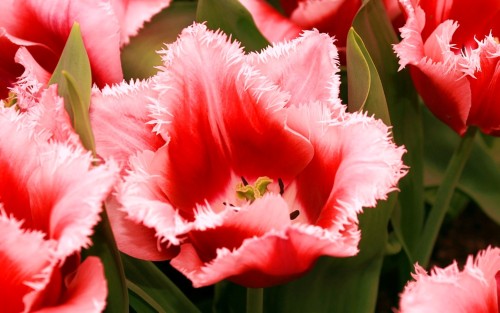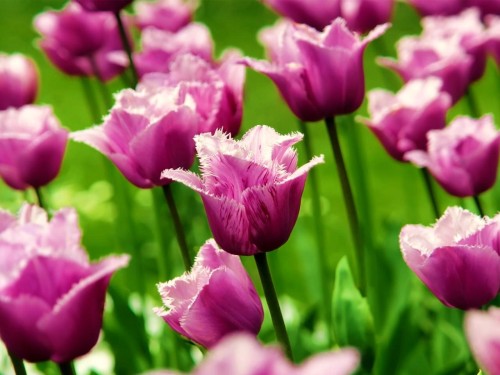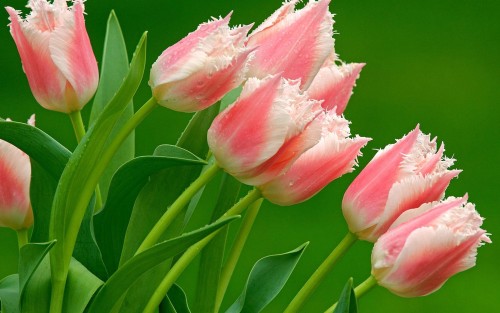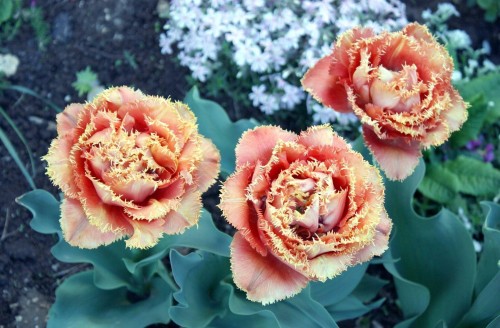Many bright tulips are associated with the spring, with the May holidays. If you like these elegant plants, you want to rejoice in their flowering at the beginning of the summer season, then replenish your collections with terry tulips. And we will tell you whether there are features in their cultivation in the garden.
Content
Interesting facts about tulips
Holland is rightly called the "country of tulips", because these colors pay a lot of attention there, they are engaged in the elimination of amazing varieties, the varieties foundation are determined, which then fall into the hands of flower water and are purchased by representatives of commercial organizations. But the first tulips appeared in ancient Greece. Then these plants were found in Persia, they began to call them tulips. Probably the name happened from the Turkish words "Turban" (headdress) or "Tulbend" (tissue used in the manufacture of turbans). Previously, the Turks had a fashion - to decorate their hats with alive flowers. Gradually, these flowers spread in Europe - in Portugal, Germany, France, Austria, England, Holland. And in Russia, flowering tulips appeared and began to decorate the gardens due to the command of Peter the first. Now there are already more than 80 species of these perennials belonging to the Lily family. For the spring, these plants have time to please us with flowers, after which they are fruit, and under the ground there is a bookmark of young bulbs, the old bulb after flowering dies. During the period of rest (this is the summer months, and in individual species and winter) inside each bulwing, the formation of incarnations of escape and flower of the future season, the budding of the kidney potential bulk. In the fall, roots are formed on it, and the process of laying a fruitless escape is completed. Outside the bulb is covered with scales that perform a protective function. She has a modified disc-shaped stem (donation), as well as basic scales (from one to six), these are specialized leaves. Now there are already more than 1,800 varieties of these plants. And if you plant not only early varieties, but also late, then they will gradually disclose their buds and the first half of June. Staying a flowerfish from growing simple scarlet tulips, but gradually other species appear in their garden:
- liliece (have similarities with delicate, elegant lilies), for example, "Aladdin", "Burgundy", "Dianito";
- parrot (their petals of the edge are deeply cut, similar to the raster tricks of parrots), it belongs to the varieties of "Estella Rainweld", "Black Pyrrht", "Fantues";
- green concave (their "boxers" have strokes, specks and other "paintings" of green shades), for example, varieties: "Artist", "Hollywood";
- bacchromy (by the edge of the petals there is a pronounced "fringe"), for example, at the varieties of "Lisa", "Mustang", "Laverok", "Barbados", "Canasta", "Johann Guttenberg", "Esterone";
- terry (or pionic) - their cups are voluminous, contain several rows of large petals.
Variety of varieties of terry tulips
All tulips available today, and their varieties are already more than 1800 (according to some data much more - about 4,000) divide into fifteen classes. Five and a half percent comes from terry early tulips. Representatives of this small group although low (from 20 to 30 centimeters), but give luxurious flowers, retaining decorativeness within 14 days. The diameter of such a wonderful flower from 8 to 10 centimeters. They usually place them in the foreground of the spring flower beds either as a cute curb along the wall of the house or track. This is a good embossing option to give in February or march to close and native people flowering in a pot plant. And now let's turn to the list of more famous varieties:
- "Abba" is amazingly, but the ten-grantime stalk holds a large scarlet flower.
- "Monte Carlo" - on low solid durable flowers bang "Suns" - saturatedly yellow multi-row bowls. Greeting in the gardens began in 1955, the variety showed loyalty to weather vapors and disease resistance.
- "Monte Orange" - similar to the previous one, the difference only in the color of the flower - it is orange.
- "MONTREUX" - a refined aroma comes from these snow-white colors.
- "Orange Princess" - with its bright orange colors will certainly raise you the mood and desire to work.
- "Freeman" - and this sustainable disease and weather "surprises" varieties of lush orange flowers are even larger - from 12 to 15 centimeters in diameter.
- "Queen of Marve" is significantly higher than its aligns (40-50 centimeters), appeared in 1982, gives large pioneer flowers of pinkish-lilac coloring.
- "Verona" - unusual cream flowers are revealed on durable stems.
- The "terry red" - it is clear from the name that the color of flowers will be a scarlet, from afar, it seems that these large poppies opened on the plant.
- "Alek Tom" is a combination of shades of brown, red and black, anthers Dark purple, and the bottom is yellow.
- "MONSELLA" - "born" grade in 1981, over decades showed sustainability, large flowers are revealed on rolling stems, on the yellow petals of which are red stripes.
But more advantages and decorative properties are celebrated in late terry tulips. From the total mass of the tulips, the niche of this class is approximately 3.2%. In each of their "glass" you can count 18 (or more) petals. In their names there are English word "double", literally: double. When only the first terry tulips began to get, then they had not one row of petals, but two. Petals rounded shape, wide, similar to peonies, so they received the second name - pionic. The height of powerful flowers, as a rule, from 50 to 60 centimeters. They reveal their buds about 12 days later than the wound-filling. And the wonderful flowering continues about three weeks (including the first week of June). During this time they will see and appreciate all your acquaintances.
- "Angelica" - a longtime variety, it looks at the transition of gentle pink tones in more saturated. On dark pink petals are noticeable divorces whitish or coral shades. Flower comes unobtrusive fragrance.
- Orange Angelik - Received with the participation of the "Angelik" grade, only the color of the orange flower.
- "Charming Lady" (translated as "charming lady") - also received from "Angelik", pink strokes are visible on golden-apricot large petals. And another plus of flowers - they are fragrant.
- San Laver (can be translated as a "loving sun") - petals orange-yellow, the reddish strokes are visible on them.
- Miranda is very magnificent flowers represented by shiny red petals, the number of which can be up to 50 pieces in one cup.
- "Dream Touch" - red-burgundy petals, each is underlined bordered by a silver-white strip.
- "Redwood" - can give three and more richly red flowers on one blur.
- "Blue Diamond" - its petals purple-purple.
In general, the color of the flower depends on the combination of carotenoids, anthocyanins (cyanidine, pelargonidine, dolphinidine) and flavonol.
If you like pink terry tulips, we advise you to purchase a variety: "Angelik", "Up Star", "Pink Star", "Drumline".
Looking for terry tulips red? Then you are suitable "terry red", "Redwood", "Miranda", "Abba".
Want to add yellow terry tulips to your flower arrangements? Try to purchase a variety: "Yello Pomponet", "Monte Carlo, Yellow Spider", "San Laver".
We mention and other original varieties:
- "Russian Bogatyr" (luxurious flowers with gentle-violet petals, covered with white "peas");
- "Danceline" (Petals White, there is a raspberry crap, and a gray-haired mean);
- "Ice Crim" (raspberry-white flowers);
- "Symphony" (cherry-red);
- "Artist Double" (combines different tones and halftone red, orange and yellow;
- "Menton Exotic" (Petals of soft coral color);
- Bonanz, sometimes writes "Bonanza" (red, with yellow edging).
But breeders continue their work, now it is mainly focused on the tulip, several bright decorative qualities are advocated in the tulip. Recently, an amazing species of terry-fringe tulips began to appear at exhibitions:
- "Mascotte" (Translated: "Amulet") - in fragrant large flower Purple petals with neat needle fringe on the edge;
- "Queensland" - "Glass" is filled with gently pink, framed by fringe petals;
- "Sensual touch" (otherwise "Sensual Touch") - a cup consists of a variety of fruitful apricot shades of large petals;
- "Cool crystal" (otherwise "Cool Crystal" - in the terry flower there are two shades of pink: gentle and bright;
- "Kingston" - gives bright flowers of raspberry colors;
- "Artichoke" - in the flower of the petals of the canary, and inside - orange, the edges with densely arranged needles;
- "Brest" - a saturated pink tulip with a white fringe border;
- "Dutch Pioneer" is a novelty with orange petals, which have yellow thick fringe;
- "MON AMOUR" is now considered to be the most spectacular of yellow tulips.
Features and nuances of growing terry tulips
- The bulbs of the varieties belonging to the Rannetsteen, plant in the soil for about 10 days earlier than those ranked in the Late Blowing.
- The roots grow when the temperature rests in the range from +6 to +10 degrees.
- It is convenient and practical to land in plastic lattice containers.
- Improved manure in places landing can not be made. Do not take it and for feeding developing plants, in order not to burn their thin roots. Instead, it is taken compost and specially formed fertilizer for bulbous.
- If you want to cut the terry tulips for a bouquet, then definitely leave several leaves from the plant. The more you leave them, the larger the plant will form a bulb under the ground.
- Be sure to carefully break the petals of the tulips when they start fading. If this is not done, then there is a weakening of the bulb under the ground, it is less than the supply of nutritional connections. This procedure is called "decapitation", during manipulation to the stalk, do not touch. Do not cut off the above-ground part.
- Fertilizers need to use instant. Chlorine-containing fertilizers do not take, they can harm tulips.
- Dropping out the container or from the flowerbeds of the bulbs of terry tulips is necessary every year, otherwise they are minced, losing varieties, they can even be rotting. After digging, the bulbs shake off the ground, dry on paper sheets. Then wrap each variety in a separate sheet, on which sign the variety. So the bulbs are well saved, if we put them in a dry, dark place.
- It is desirable to plant terry tulips annually in different places of the garden. If there is no such possibility, then you move them every three years.
Planting tulips
Successfully place tulips on the flowerbed along with perennials. Then in the spring you will admire the tulips, then the foliage of perennials will grow lush, it will hide the yellow leaves of your bulbous. And then this flowerba will be all summer to fly with other flowers.
Expressive compositions are obtained if terry tulips are placed with anemones, crocuses, hyacinths, pansies, stamps, Arabisms, primoses, forget-me-not, iris, daisies, ripples, narcissus. Great terry tulips look great if they are planted next to the forssee or spirires.
The veranda (or loggia) can be decorated with gorgeous terry tulips, if we plant some varieties in vases or containers.
It is very important to choose the right time for planting bulbs. The most optimal is the last decade of September or October. Focus on the average daily temperature - it must be +9 degrees. If the weather is "indispensable" by warmth, the formation of roots is delayed, there is a risk of fusariosis. If freezing will come quickly, then the bulbs may not have time to root up to the arrival of persistent cold. And for this you need at least three weeks. Places of tulips highlight a little elevated, where water will not be for a long time. Terry tulips need abundance of sun rays. The landing should certainly be protected from the busting of the wind, otherwise the stalks will not stand under their onslaught, because they are crowned with a large flower consisting of a variety of petals. The best soils are loose, "air" enriched with humus. If on the site is clay, heavy, poor soil, then before planting the bulbs it must be improved by repairing humus, sand, ash and peat. The closest way to find groundwater can also destroy the bulbs, in this case we need a layer of drainage materials. The soils with an acidic medium for tulips are not suitable, the medium correction is carried out with the help of dolomite flour. It is made at the peroxide and elimination of weed herbs. Before the procedure for sending bulbs to the ground, carefully inspect the entire seating material, get rid of dried, fallen, damaged bulbs. Those that have been checking, soak for 30 minutes in a pink solution of potassium permanganate (this is a well-known manganese). Prepare holes or furrows and send bulWhi in them. We advise depth to calculate this: multiply the height of the bulbs to three. If the ground is sandy, then the bulb is plugged, if drums, it is not too deep. Distance between bulbs - 10 centimeters. If there is a lot of landing material, then leave a distance of 25 or 30 centimeters between the rows. The wells or furrows first water with water in which crystals of manganese or growth stimulant have been added. Then I spray the bottom with river sand, and only then lay onions in them. Attention! Put the bulbs with effort into the soil can not! If the autumn is dry, there is little precipitation, then sometimes the places of landings moisturize. When frosts (November or December) come, then planting sites of bulbs are inspiring a five-point meter of peat. In the spring, this layer can not be removed.
How to care for garden tulips?
In the spring of the earth, young leaves will be shown. Periodically loose the soil around them, without giving shock weeds to float this space and select food from varietal tulips. Watch that the top layer of the soil on the flowerbed (or bed) with terry tulips was always wet. Watering are welcome moderate, but regular. If spring rainy, then all the watering for you will make nature. Watering Do not stop two weeks after flowering. By the way, it is more expedient to carry out loosening after irrigation or natural precipitation.
So that terry tulips showed all its splendor, during growth, they need to fertilize:
- First, the sprouted bulbs need nitrogen feeders, after which you immediately see the result - a rapid growth.
- Noticed boutons? Then it's time for making phosphorus-potash connections. They will contribute to the consolidation of buds.
- When the lush flowers opened, then the plants can be fed by mineral complexes.
If the terry tulips beat Grad, then to prevent the outbreak of gray, they rot immediately after the bad weather, spray the affected plants with a fungicidal preparation.
If spring is issued raw, the tulips can be amazed with fungal diseases (for example, rotten, root, gray, botritious, white, wet, and fusarium and tripides). To protect your flowers, carefully follow all the rules of their cultivation. Some flower products are carried out by fungicides - for prophylaxis.
When the plants are found on the plant, it is necessary to immediately remove it with a lump of soil from the flower, so that the virus does not move to other flowers. Unfortunately, there are no ways to combat this virus. Be sure to span a straight to a very hot rich solution of manganese.
The yellowing of the leaves is a signal for the gardener, which is time to dig up from the ground of the bulbs. Just do not wait for a complete drying of the above-ground part, otherwise the "Nölezdyshko" from the bulbs will decay under the ground. Approximate deadlines - the last days of June and to the top of the summer. Sew them is preferably under a canopy where the rays of the sun do not fall. Temperature should be no more than 29 degrees. Until the last numbers of August, store their bulbs in a periodically ventilated room, where the temperature is about 20 degrees, and then the temperature should be lower (about 17 degrees) until the time for planting comes.
You can propagate pionic tulips with the help of "kids" that are digging along with a substitution bulb in the middle of summer. These small "kids" from the "nest" then fall on the fall together with the main. For the year "Baby" will grow to large sizes and will be ready for flowering. But a long seed reproduction use breeders to get new impressive varieties.
When the cold come, the places of landings are covered with spruce "paws". Such measures are needed to protect the bulbs from rodent encroachments. Yes, and the bulbs will continue, even if the snow is not enough. It is necessary to clean such a shelter in early spring.
We hope that our advice will help you purchase suitable varieties and grow beautiful terry tulips in the garden or near high-rise buildings that will cause enthusiastic views from relatives, friends, neighbors.

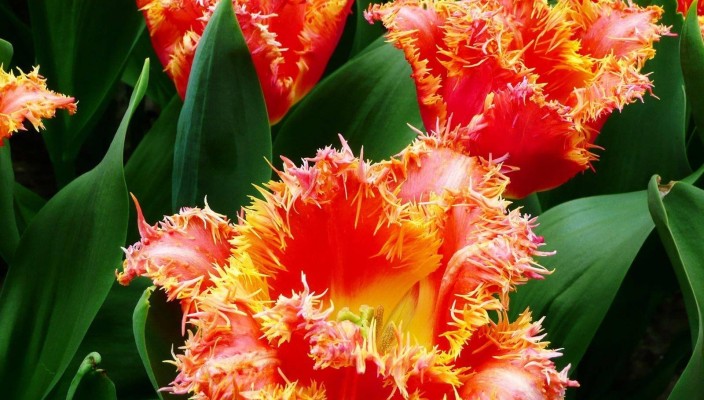
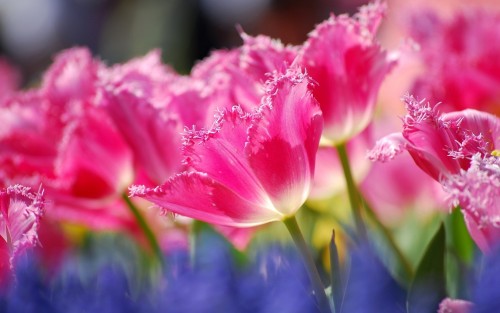
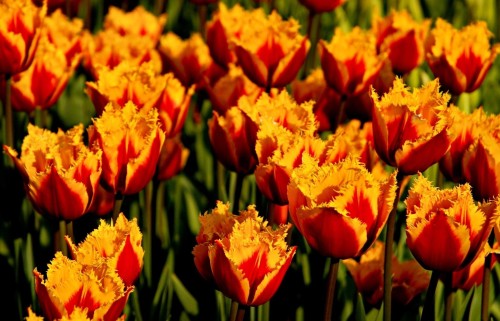
![2816x2112_640042_ [www.artfile.ru]](http://gid-str.ru/images/gidstr/2016/06/2816x2112_640042_www.artfile.ru_-500x375.jpg)
